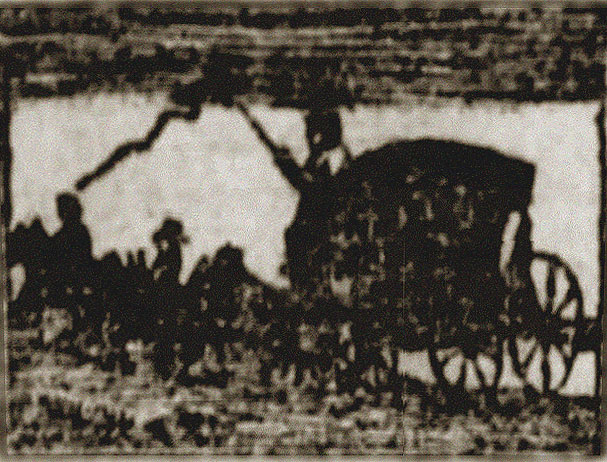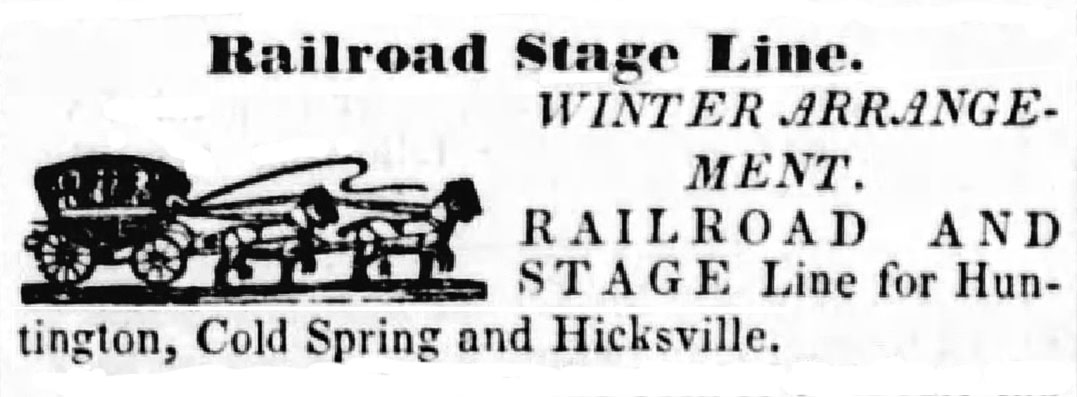

Over two centuries ago, the murky image you see headed a composite schedule of Long Island stagecoach services. It appears to depict a four-horse stage. With a bit of whimsy, the artist has placed the end of the coachman’s whip perilously close to a man's head on horseback.
 Long Island Star, July 30, 1817
Long Island Star, July 30, 1817
Mass transit consisted of stagecoaches that struggled along muddy dirt roads in those days. There was no Hicksville yet, but if you took a particular stage, you could get pretty close to where it would sprout later. Once a week, a stagecoach left Brooklyn for Jericho, and a day or two later, it returned to Brooklyn.
A Railroad With a Vision
The cities of New York and Boston were vital to the turbulent economy of the fledgling nation, but communication between them was slow. People and documents had to be carried by horse, stage, or newfangled steamboat. Railroads promised to be faster, but in the 1820s, no one thought they could conquer the shortest route – the irregular and rocky Connecticut shoreline.
The founders of the LIRR had a new vision. They intended to create a railroad of swift trains that carried important passengers (i.e., businessmen) from New York Harbor to a distant North Shore port, where they would board an LIRR steamboat bound for the New England coast just south of Boston. Bostonians would travel the same route in reverse. There would be as few stops as necessary along the way.
Many Long Island towns would get railroad stations, but only because building a station was a requisite if you wanted to lay track through a populated place. Ideally, “Boston Trains” would ignore these places because the emphasis was on fast (and profitable) end-to-end service. As far as the railroad’s stockholders were concerned, rural Islanders had been getting around for decades via stagecoach, and the stage lines could have them.
The Best Laid Tracks...
Things did not go as planned; the nationwide Panic of 1837 interrupted construction east of Westbury. The LIRR could not move people between Boston and New York with the partial infrastructure it had built, but could it get enough revenue to outlast the depression that had literally stopped it in its tracks?
The place where it had stopped was given the name HICKSVILLE, after Valentine Hicks, LIRR President. A handful of things would have to be built so that Hicksville could function as the terminus of the line from Jamaica until construction resumed:
- buildings/sheds to store tools, spare parts, oil, cleaning supplies, and dry wood (early locomotives burned it as fuel)
- a well, pump, and water tank (locomotives carried water to turn into steam)
- holding tracks (for locomotives and railroad cars not running at the moment),
- a “turnaround track” (so that locomotives at the end of the line could be turned around to point back at Jamaica)
It was Spring, and the railroad hoped that crops from farms several miles away might be shipped West to market in the summer. Passenger traffic – the local traffic it had once disdained, but paying customers nonetheless – would help, too, but a newborn town didn’t have a built-in supply of passengers. Or did it?
Cue the Coachmen
Hicksville had the railroad but no passengers. Eleven miles away (which was not “right next door” in the horse-drawn era), Huntington had no railroad, but – along with some nearby communities, like Cold Spring – it had residents who sometimes wanted to travel on the new LIRR. Soon, the railroad cooperated with the stagecoach operators it had once dismissed.
In hindsight, this was not a surprise. Since the 17th century, residents of Huntington had been in close communication with other English colonists, especially those in Amityville and Jerusalem (today’s Wantagh). Their well-worn paths had become wagon roads, and as newer settlements came to be, these wagon roads stretched and bent to accommodate them. Stagecoaches tended to follow the most-used roads. Huntingtonians long had traveled to Cold Spring and East Norwich (think Route 25A), gone on either north to Oyster Bay or south to Jericho (think Route 106), and from the latter went on to Jerusalem (think – duh – Jerusalem Avenue).
Once Hicksville... well, materialized, it took no great leap of imagination to add it as a stop for the Huntington-Jericho stage. Indeed, it was obvious that the LIRR itself got involved and soon was managing the stage operations.
Melons
 Thinking ahead: The LIRR announced its Winter stage schedule in July.
Thinking ahead: The LIRR announced its Winter stage schedule in July.
Brooklyn Evening Star, July 6, 1843
In the above announcement of the LIRR’s “Winter Arrangement,” the horses look rather like dogs, and the depiction of the coach is probably equally inaccurate. Stages of the 1840s typically were of the “melon” type, so called because their oval profiles reminded people of melons on wheels, with appendages at the front and rear. One is shown below.
Forty etchings from Sketches Made with the Camera Lucida in North America in 1827 and 1828
Captain Basil Hall, R[oyal] N[avy] Edinburgh, London, 1829
holdings of Thomas Fisher Rare Book Library, University of Toronto

The actual experience of riding in a melon was quite far removed from that of, say, Cinderella riding in her pumpkin. The sea captain who drew the sketch above, having traveled by stagecoach around much of Eastern North America, wrote this:

This account is echoed by other sources, including ones that specifically describe riding the Huntington-Hicksville stagecoach.
 Brooklyn Daily Eagle, December 18, 1909
Brooklyn Daily Eagle, December 18, 1909
From the above excerpt, one might infer that top-heavy stages sometimes overturned. They did, especially where hard-frozen, slippery mud occurred alongside a tempting ditch. The following report follows up on the continuing efforts of Hicksville’s Dr. E. G. Rave to treat injured coach passengers following the toppling of a stagecoach at Lindenhurst in 1888.
 Note: Breslau was then the name for Lindenhurst. Huntington Long-Islander (Hicksville column) December 14, 1888
Note: Breslau was then the name for Lindenhurst. Huntington Long-Islander (Hicksville column) December 14, 1888
Fame, of a Sort
Stagecoach drivers on the Island sometimes became local legends. “Uncle” Jesse Conklin drove -- and later managed – the Hicksville-Huntington stage line over a career of 50-plus years without missing a day of work. Apparently, there was more to him than his friendliness and work ethic. Oliver S. Charlick, hard-nosed President of the LIRR in the 1860s and 1870s, once famously introduced Conklin to the railroad’s Board of Directors as “the only man who ever got the best of Oliver Charlick.”
Brooklyn Daily Eagle, October 14, 1894
In addition to serving passengers on the Hicksville-Huntington route, Conklin was also the official government postal carrier between the two locales. For a time, he also drove stages between Huntington and Cold Spring for a competitor of the LIRR. These stages met the steamboat American Eagle, which in the early 1840s sailed to/from Manhattan’s Fulton Market.
After the Melon
It appears – one cannot be certain, as photographs of stagecoaches on the Island are uncommon- that the Hicksville-Huntington stage service eventually adopted a newer type of vehicle. The following drawing, included in the same article as the above portrait, shows a retired stagecoach left in a grassy field, apparently with screens in the windows. A banner strung across the rear door appears to say Huntington.
Brooklyn Daily Eagle, October 14, 1894
The elaborate paint scheme (which may have been applied by the manufacturer of the coach, as it appears on vehicles used in many different places) helped me discover some historical photographs that may give us a better idea of how this coach looked when it was in service.
5th Avenue and 33rd Street, Manhattan, c.1880
New York Historical Society Negative no. 391
(Note: This is only a portion of the entire image.)

Compared to a melon coach, this stage was of lighter construction and thus required only two horses. It looks airy and probably was quite drafty in winter.
This stage appears to be very similar to the one drawn in the newspaper article, the main difference being that this one has a clerestory projecting upward from the roof. Very popular in the 19th century, a wooden clerestory roof was meant to improve ventilation and, in the daytime, interior light levels. Over long years of service, it was prone to leak and rot and often was eventually replaced by a slightly convex or flat roof.
This image shows another possibility: a flat-roofed version with a railing to allow luggage to be carried overhead.
 Although the source dates this photograph to
Although the source dates this photograph to
1896, the woman’s dress looks a lot like 1870s fashion.
ghpl.org/timeline
from the
Grandview Heights Marble Cliff Historical Society
and Grandview Heights [Columbus, OH] Public Library
A Slow Death, and then Forgotten
Long Island’s stagecoach services were a long time dying. Years after the LIRR reached its eastern limits, many lingered. In fact, one line between Brooklyn and Freeport was still in business until at least 1907.
Given how it started, the Hicksville-Huntington line operated longer than expected: the stages ran for at least 30 years. Although the LIRR was extended to Farmingdale in 1841, a branch to Huntington was not opened until 1868. Even then, the LIRR did not technically reach Huntington. It built a station outside of town, giving rise to place-name Huntington Station. I have not been able to verify just when the Huntington-Hicksville stagecoaches ceased running, but I believe the date was in the 1880s.
Note that some of you readers may be descended from the many people who came to Hicksville in the second half of the 19th century and helped it enjoy its Golden Years. If so, your ancestors likely rode coaches to travel to the many places the LIRR never reached.

